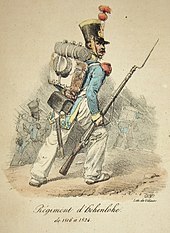Hohenlohe regiment
The Hohenlohe Regiment was a military association that was set up by French royalists to fight the French Revolution and at times also served in Dutch, Austrian and Russian services. In 1814, what was left of it became an association of the French army , which is considered a forerunner of the Foreign Legion founded in 1831 .
Beginnings
The Hohenlohe - Bartenstein and Hohenlohe- Schillingsfürst regiments were the nucleus of the Hohenlohe regiment, which became part of the French Foreign Legion in 1831 . They were erected in 1792 and merged in 1794. After 1805 the Hohenlohe-Bartenstein Infantry Regiment was in Russian service, then it was called: Infantry Regiment Michael Grand Duke of Russia No. 26. After several name changes, it had its original name again when it was dissolved in 1831.
In 1789 the French Revolution broke out. Numerous royalists , emigrants from France, at their head the brothers Louis XVI., Came to Germany in the following years. The Princes zu Hohenlohe-Schillingsfürst and Ludwig Leopold zu Hohenlohe-Bartenstein supported their attempt to raise an army to restore the "old order" in France . In 1792 they set up two regiments to help the Bourbons in the fight against the revolution.
Prince Ludwig Aloys zu Hohenlohe-Waldenburg-Bartenstein became the commander of the hunters (Chasseurs á Pied) and Prince Karl Joseph zu Hohenlohe Bartenstein became the commander of the fusiliers. In addition, former officers in French service were hired. The Hohenlohe mercenaries came mainly from the areas around Pfedelbach , Bartenstein and Schillingsfürst. Recruiting was slow, but in the end around 900 men came together and were placed under the army of Prince Ludwig Joseph von Bourbon-Condé .
Calls
Initially, the regiments in the Palatinate, the Netherlands and the Upper Rhine fought against the French revolutionary troops. In 1794 they were merged to form the Hohenlohe Regiment and in the same year switched to Dutch services. Under the orders of Colonel Durand, the association was supported by Russian subsidy payments from 1797 . The Hohenlohe-Durand regiment was also in Austrian service at times. In battles in Holland in the same year, the regiment Royal Hohenlohe was almost completely destroyed. The survivors were captured or drowned in the frozen Zuiderzee. In 1805 the regiment stood out under the leadership of Major General Ludwig Alois Fürst zu Hohenlohe-Bartenstein. It fought at Caldiero near Verona under the command of Archduke Charles . In order to compensate for earlier losses, the regiment was supplemented by soldiers from Carinthia .
After the Congress of Vienna in 1814, Prince Ludwig Aloys zu Hohenlohe-Bartenstein became French lieutenant-general and inspector of the infantry. He was allowed to set up his own regiment, the so-called Régiment de Hohenlohe , which consisted of remnants of the Hohenlohe-Durand regiment and Napoleonic foreign regiments. By royal order of August 11, 1815, the establishment of the Légions départementales was ordered. 87 of these legions were formed - one of them was a so-called Légion royale étrangère (English: Royal Foreign Legion). Even after the dissolution of the Napoleonic Army in 1815, the unit remained as the Régiment de Hohenlohe . In 1821 it was renamed the 2 e Régiment d'infanterie légère . In 1827, Prince Ludwig Aloys became Maréchal de France and Peer of France . The status of a pair of France was the highest in the French nobility and was bestowed by the king. He died in Luneville on May 30, 1829.
resolution
The regiment was stationed near Marseille at this time . After the July Revolution of 1830, the soldiers of his regiment could take on French citizenship. Those who were not ready had to join the French Foreign Legion founded in 1831 or return to Germany.
Individual fates
A son of the Hohenlohe-Bartenstein court blacksmith described in a letter to Bartenstein from 1805 that he had deserted from the regiment to Switzerland as a wounded man. Since he was not allowed to practice his blacksmithing there, he let himself be recruited into Spanish military services by recruiters. He fought against the Moors for six years in the service of the Spanish king in Melilla / North Africa. As a company corporal in the 3rd Battalion of the Infantry Regiment Irlandais (called Regiment Irlandia in the letter) he then lived in Cádiz . There his traces are lost.
The son of the Hohenlohe-Bartenstein court grocer did not return to Bartenstein until 1836 after the regiment was dissolved. Here he was completely unknown. Together with the local pastor, he set up a genealogy to prove his identity. A short time later he died impoverished in a house outside the village.
swell
- Thomas Krause: Traces of the Foreign Legion in Schillingsfürst , Schillingsfürst o. J.
- Anne and Claus Reimann: Bartenstein as it used to be , Niederstetten 2009
- Uwe A. Oster: Prince Ludwig Aloys zu Hohenlohe-Bartenstein . In: At that time 08/2002
- Gerhard Taddey (Red.): Pfedelbach 1037–1987. From past and present (= research from Württembergisch-Franken. Vol. 30). Published by the Pfedelbach community. Thorbecke et al., Sigmaringen et al. 1987, ISBN 3-921429-30-7 .
- Hohenlohe Central Archive in Neuenstein
- Archive Schrozberg, part of Bartenstein
- The Hohenlohe-Bartenstein Infantry Regiment at the Battle of Caldiero, Vienna 1891
Web links
- Traces of the Foreign Legion in Schillingsfürst on partnershipsverein-schillingsfuerst.de
- Feldzeugmeister Fürst zu Hohenlohe-Bartenstein on napoleon-online.de
Footnotes
- ^ Pierre Montagnon: Histoire de la Légion. De 1831 à nos jours . Pygmalion, Paris, 2nd edition 2008, ISBN 978-2-7564-0243-7 , pp. 12-13.
- ↑ Etienne Alexandre Bardin, Nicolas Charles Oudinot : Dictionnaire de l'armée de terre ou Recherches historiques sur l'art et les usages militaires des anciens et des modern , Vol. 5: Guerre D'Alger - Marine . Perrotin, Paris 1849, p. 3169.
- ↑ Etienne Alexandre Bardin, Nicolas Charles Oudinot: Dictionnaire de l'armée de terre ou Recherches historiques sur l'art et les usages militaires des anciens et des modern , Vol. 5: Guerre D'Alger - Marine . Perrotin, Paris 1849, p. 3149.


